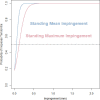Iliopsoas tendonitis after total hip arthroplasty : an improved detection method with applications to preoperative planning
- PMID: 36598093
- PMCID: PMC9887341
- DOI: 10.1302/2633-1462.41.BJO-2022-0147.R1
Iliopsoas tendonitis after total hip arthroplasty : an improved detection method with applications to preoperative planning
Abstract
Aims: Iliopsoas impingement occurs in 4% to 30% of patients after undergoing total hip arthroplasty (THA). Despite a relatively high incidence, there are few attempts at modelling impingement between the iliopsoas and acetabular component, and no attempts at modelling this in a representative cohort of subjects. The purpose of this study was to develop a novel computational model for quantifying the impingement between the iliopsoas and acetabular component and validate its utility in a case-controlled investigation.
Methods: This was a retrospective cohort study of patients who underwent THA surgery that included 23 symptomatic patients diagnosed with iliopsoas tendonitis, and 23 patients not diagnosed with iliopsoas tendonitis. All patients received postoperative CT imaging, postoperative standing radiography, and had minimum six months' follow-up. 3D models of each patient's prosthetic and bony anatomy were generated, landmarked, and simulated in a novel iliopsoas impingement detection model in supine and standing pelvic positions. Logistic regression models were implemented to determine if the probability of pain could be significantly predicted. Receiver operating characteristic curves were generated to determine the model's sensitivity, specificity, and area under the curve (AUC).
Results: Highly significant differences between the symptomatic and asymptomatic cohorts were observed for iliopsoas impingement. Logistic regression models determined that the impingement values significantly predicted the probability of groin pain. The simulation had a sensitivity of 74%, specificity of 100%, and an AUC of 0.86.
Conclusion: We developed a computational model that can quantify iliopsoas impingement and verified its accuracy in a case-controlled investigation. This tool has the potential to be used preoperatively, to guide decisions about optimal cup placement, and postoperatively, to assist in the diagnosis of iliopsoas tendonitis.Cite this article: Bone Jt Open 2023;4(1):3-12.
Keywords: Iliopsoas impingement; Iliopsoas tendonitis; Logistic regression models; Soft tissue; THA; Total hip arthroplasty; acetabular components; bony anatomy; femoral heads; groin pain; prosthetic; retrospective cohort study; standing radiography; tendonitis; total hip arthroplasty (THA).
Conflict of interest statement
Figures








References
-
- Beswick AD, Wylde V, Gooberman-Hill R, Blom A, Dieppe P. What proportion of patients report long-term pain after total hip or knee replacement for osteoarthritis? A systematic review of prospective studies in unselected patients. BMJ Open. 2012;2(1):e000435. 10.1136/bmjopen-2011-000435 - DOI - PMC - PubMed

